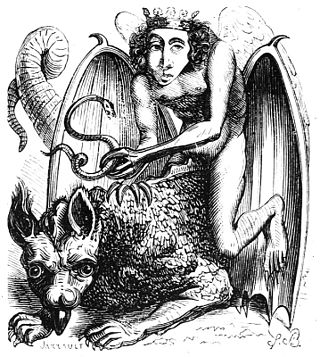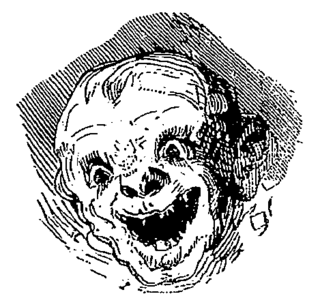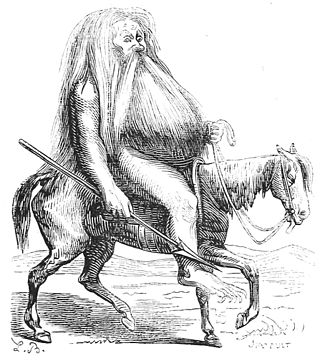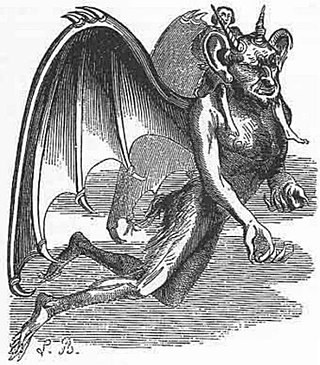

Aamon (also known as Amon and Nahum), in demonology, is a Grand Marquis of Hell who governs 40 infernal legions, and the 7th spirit of the Goetia. He is the demon of life and reproduction. [1]


Aamon (also known as Amon and Nahum), in demonology, is a Grand Marquis of Hell who governs 40 infernal legions, and the 7th spirit of the Goetia. He is the demon of life and reproduction. [1]
The names Aamon and Amon come from the god Amun or from the Canaanite god Baal Hammon of Carthage. Nahum means "who induces to eagerness."[ citation needed ]
Amon, or Aamon, great and powerful marquis of the infernal empire. He has the face of a wolf, with a snake's tail; he vomits flame; when he takes human form, he has only the body of man; his head resembles that of an owl and his beak shows very reckless canine teeth. He is the most solid of the princes of demons. He knows the past and the future, and reconciles, when he wants, the friends scrambled. He commanded forty legions. The Egyptians saw Amon or Amoun, their supreme God; they represented him with blue skin, in a fairly human form. he commands 40 legions of demons and carries the title of Prince. He reconciles friends and foes and procures love for those seeking it. The Egyptians viewed Amon or Amun as their supreme God; they represented him with blue skin in human form.
He was written about by Johann Weyer in 1583 in the Pseudomonarchia Daemonum .
Amon, or Aamon, is a great and mighty marques, and commeth abroad in the likeness of a Wolf, having a serpents tail, [vomiting] flames of fire; when he putteth on the shape of a man, he sheweth out dogs teeth, and a great head like to a mighty [night hawk]; he is the strongest prince of all other, and understandeth of all things past and to come, he procureth favor, and reconcileth both friends and foes, and rule forthy legions of devils. [3]
And much later by S. L. MacGregor Mathers in the The Lesser Key of Solomon .
The Seventh Spirit is Amon. He is a Marquis great in power, and most stern. He appeareth like a Wolf with a Serpent's tail, vomiting out of his mouth flames of fire; but at the command of the Magician he putteth on the shape of a Man with Dog's teeth beset in a head like a Raven; or else like a Man with a Raven's head (simply). He telleth all things Past and to Come. He procureth feuds and reconcileth controversies between friends. He governeth 40 Legions of Spirits. His Seal is this which is to be worn as aforesaid, etc. [4]
Harley MS 6483 of The Lesser Key of Solomon states that Amon can also enable the magician to summon and interrogate the spirits of those who drowned at sea. [5]

Astaroth, in demonology, is known to be the Great Duke of Hell in the first hierarchy with Beelzebub and Lucifer; he is part of the evil trinity. He is known to be a male figure, most likely named after the Near Eastern goddess Astarte.

Bael is a demon described in demonological grimoires such as The Lesser Key of Solomon and the Pseudomonarchia Daemonum and also in the Dictionnaire Infernal. He is described as a hoarsely-voiced king with the power to make men invisible and ruling over sixty-six legions of demons. The Lesser Key of Solomon describes him as appearing in the form of a cat, toad, man, some combination thereof, or other "diverse shapes", while the Pseudomonarchia Daemonum and the Dictionnaire Infernal state that he appears with the heads of a cat, toad, and human simultaneously.

Bifrons is a demon described in the demonological grimoires the Lesser Key of Solomon and the Pseudomonarchia Daemonum, as well as being mentioned in the Dictionnaire Infernal. These works describe Bifrons as an earl who initially appears as a monster before adopting a more human form. His duties include teaching arts and sciences, including astrology, geometry, and the properties of different plants and stones. He also moves bodies into different graves, lights candles over graves, and commands either 6, 26, or 60 legions of spirits.
The Lesser Key of Solomon, also known as Lemegeton Clavicula Salomonis or simply Lemegeton, is an anonymously authored grimoire on sorcery. It was compiled in the mid-17th century, mostly from materials several centuries older. It is divided into five books: the Ars Goetia, Ars Theurgia-Goetia, Ars Paulina, Ars Almadel, and Ars Notoria. It is based on the Testament of Solomon and the ring mentioned within it that he used to seal demons.

In demonology, Beleth, also spelled Bilet, Bileth, Byleth, or Bilith, is a king of Hell who has eighty-five legions of demons under his command. He rides a pale horse, and a variety of music is heard before him, according to most authors on demonology and the most known grimoires.
In demonology, Halphas is the thirty-eighth demon in the Ars Goetia in the Lesser Key of Solomon, ranked as an earl.
In demonology, Amaymon is a prince of Hell, and, according to some grimoires, the only one who has power over Asmodai.
Bune is a demon listed in demonological grimoires such the Lesser Key of Solomon Johann Weyer's Pseudomonarchia Daemonum, Jacques Collin de Plancy's Dictionnaire Infernal, and the Livre des Esperitz.
Gamigin is a demon described in demonological grimoires such as The Lesser Key of Solomon and Johann Weyer's Pseudomonarchia Daemonum.
Leraje is supposedly a mighty Great Marquis of Hell who has thirty legions of demons under his power. He is said to cause great battles and disputes, and makes gangrene wounds caused by arrows. He is depicted as a gallant and handsome archer clad in green, carrying a bow and quiver. Leraje is a demon mentioned in demonological grimoires. He appears in the Lesser Key of Solomon, Johann Weyer's Pseudomonarchia Daemonum, and Jacques Collin de Plancy's Dictionnaire Infernal.
In demonology, Morax is a Demon, Great Earl, and President of Hell, having thirty legions of demons under his command. He teaches Astronomy and all other liberal sciences, and gives good and wise familiars that know the virtues of all herbs and precious stones. This profile of the demon can be seen in Pseudomonarchia Daemonum as well as in Goetia.

In demonology, Furcas is a Knight of Hell, and rules 20 legions of demons. He teaches Philosophy, Astronomy, Rhetoric, Logic, Chiromancy and Pyromancy.

Gaap is a demon that is described in demonological grimoires such as the Lesser Key of Solomon, Johann Weyer's Pseudomonarchia Daemonum, and the Munich Manual of Demonic Magic, as well as Jacques Collin de Plancy's Dictionnaire Infernal,

In demonology, Marchosias is a great and mighty Marquis of Hell, commanding thirty legions of demons. In the Ars Goetia, the first book of The Lesser Key of Solomon, he is depicted as a wolf with gryphon's wings and a serpent's tail, spewing fire from his mouth, but at the request of the magician he may take the form of a man. He is a strong fighter and gives true answers to all questions, and is very faithful to the magician in following his commands. Before his fall he belonged to the angelic order of Dominations, and when he was bound by Solomon he told him that after 1,200 years he hoped to return to Heaven.

In demonology, Malphas is a demon who first appears in Johann Weyer's Pseudomonarchia Daemonum. That work and the Lesser Key of Solomon describe him as a mighty Great President of Hell, with 40 legions of demons under his command and is second in command under Satan. He appears as a raven, but if requested, will instead resemble a man with a hoarse voice. Malphas is said to build houses, high towers and strongholds, throw down the buildings of enemies, destroy enemies' desires or thoughts and all that they have done, give good familiars, and quickly bring artificers together from all places of the world. According to the writers, Malphas accepts willingly and kindly any sacrifice offered to him, but then he will deceive the conjurer.

In demonology, Raum is a Great Earl of Hell, ruling thirty legions of demons. He is depicted as a crow which adopts human form at the request of the conjurer.
"Raum, Reym (Rey) or Raim is a great earle, he is seene as a crowe, but when he putteth on humane shape, at the commandement of the exorcist, he stealeth woonderfullie out of the kings house, and carrieth it whether he is assigned, he destroieth cities, and hath great despite unto dignities, he knoweth things present, past, and to come, and reconcileth freends and foes, he was of the order of thrones, and governeth thirtie legions."

In demonology, Orobas is a powerful Great Prince of Hell, having twenty legions of demons under his control.

Gemory is a demon listed in demonological grimoires.
Amy is a demon described in demonological grimoires such as the Lesser Key of Solomon, the Pseudomonarchia Daemonum, and in the Munich Manual of Demonic Magic; as well as Jacques Collin de Plancy Dictionnaire Infernal,